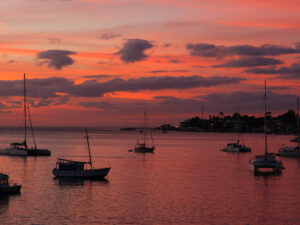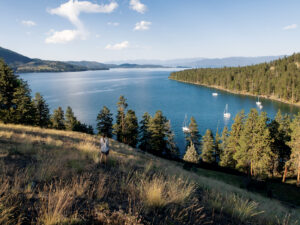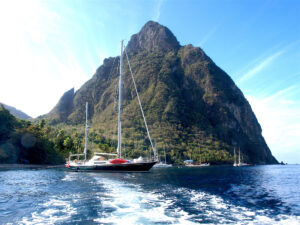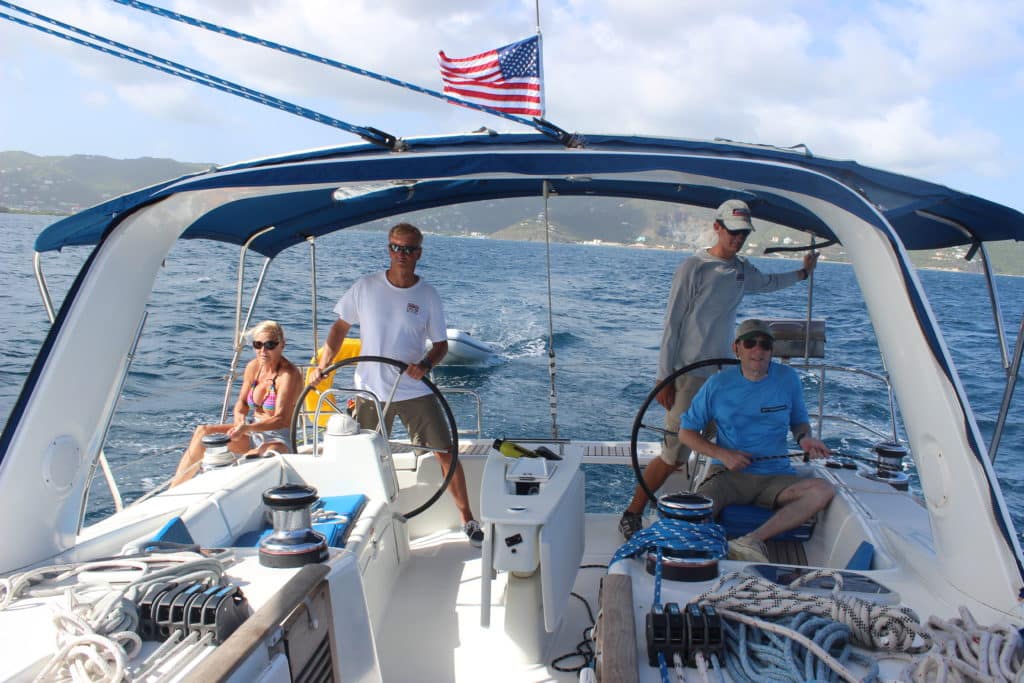
It felt like finals week in college all over again. While I sat desperately trying to study, nearby I could hear the parties thrown by those whose responsibilities were behind them. Only this time, the revelers were the patrons of William Thornton, better known as Willy T’s, the pirate ship turned dive bar in the back corner of the Bight at Norman Island, in the British Virgins, and my study materials were the textbooks provided by the Colgate Offshore Sailing School in my Fast Track to Cruising course.
Perched in the cockpit of our Beneteau 50.5, I tried to ignore the thumping of bad ’90s rap. The whirr of a blender from our galley drowned out the music for a passing moment, and seconds later, through the companionway came my instructor, Brian, who handed me a perfectly blended piña colada. Maybe this wasn’t quite like college after all.
The Fast Track to Cruising program is one of a handful offered by Colgate Offshore Sailing School in an effort to educate and vet future charter customers. Its partnership with The Moorings gives graduates a sort of passport to Moorings charter fleets around the globe, save for a few locations that require further testing or certification.
The program I signed on with involves two days of learn-to-sail instruction followed by four days of bareboat chartering classes. Those who already know how to sail can test out of the first portion or, like I did, jump into a Colgate 26 for a two-day instructional refresher.
My family chartered a handful of times when I was growing up. Back then, though, my dad, an experienced sailor, would show up at a charter facility and answer a few questions, and then they’d hand over the keys to a 50-something-foot cruiser without any additional checks or balances, waving us off. While undoubtedly many miss the simpler days of bareboat chartering, I for one am thankful that I followed a full curriculum and have total confidence in my ability to skipper a sailboat for a week. Plus, hands-on learning in the Caribbean never hurts.
During our week of fun in the sun, we went over everything from man-overboard drills to docking under power, points of sail to heaving to. With three written and three sailing tests conducted over the course of the week, our curriculum was just serious enough for us to be learning, but just relaxed enough to let us still have fun.
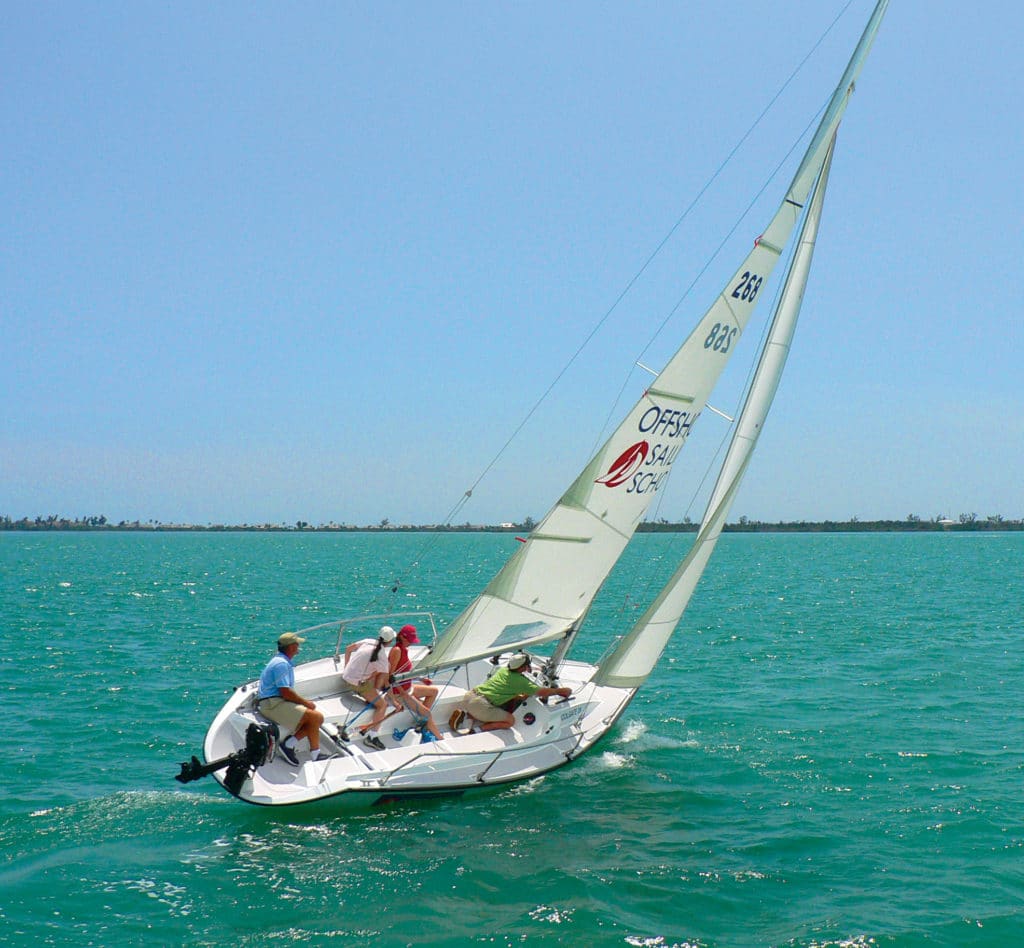
Our cast of characters seemed comical at first, but the spaciousness of the Beneteau 50.5 kept us all friendly throughout the week. There was me, the 25-year-old editor on a mission; our instructor, Brian, who has been a part of the Colgate School for years and is currently on a two-year stint in the BVI (not too shabby); a couple from Colorado hoping to soon retire and live aboard; and a man from Brooklyn with dreams of chartering with his wife and two daughters.
While the course is certainly structured to accelerate those with little to no sailing experience from novice to confident charter captain, it’s equally beneficial for those looking to reinforce their skills before embarking on a solo command. “The important part of the first couple of days on the C26 is to learn basic sailing skills, or brush up on what you already know,” says Kevin Wensley, Offshore Sailing School’s director of operations. “We cover how to steer by the telltales, how to maneuver, and how to handle MOB situations. It’s easier to learn on a small boat because it’s so responsive. You get immediate feedback to any adjustments you make.”
After those first two days, students switch over to a Beneteau 50.5 charter boat, a cushy 50-foot monohull with five cabins and, yes, air conditioning. “The performance is great,” says Wensley. “Fifty feet is as big as an average-size family is going to want to take out, so we want to give people experience aboard.”
“The Moorings is very standardized across the fleet,” adds Ian Pederson, marketing manager for The Moorings, which is under the TUI Marine umbrella. “You can charter the same model boat that you learned on anywhere in the world that The Moorings has a base.”
Well, almost anywhere. A student who completes his or her certification in the BVI can then charter any monohull, up to 50 feet long, at bases in countries that don’t require additional paperwork. The International Proficiency Certificate can be obtained through a simple application process with no additional testing, and several charter companies offer courses that can help you meet other certification requirements for primarily Mediterranean chartering.
Though we didn’t make it out of sight of Tortola at my Fast Track to Cruising course, it’s easy to fantasize about all the places your certification could take you. Christine Cooper and Bruce Putzman, two of my classmates, plan to retire soon and buy a boat to sail around the world and live aboard. In the meantime, they plan to charter. “The goal is for us to learn how to sail together the best we can,” Cooper told me one night while we were moored off Jost Van Dyke. “There are so many amazing places in the world that we’ll get to see once we’re both competent sailors.”
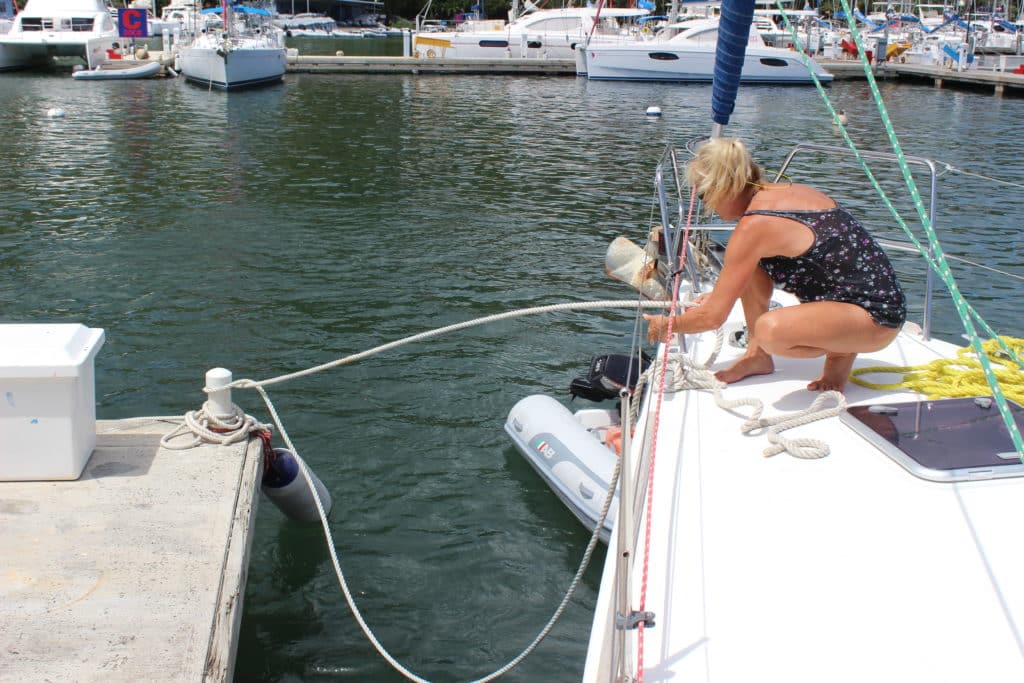
Over the course of our week together, Christine and Bruce; our other classmate, Steve; and I certainly became competent. We practiced docking drills on Scrub Island, picked up a “man-overboard” buoy in the calm waters off Virgin Gorda’s Baths, and even snapped a halyard, learning firsthand how valuable The Moorings’ support team is; at Scrub Island, the Moorings staff arrived with a replacement boat, and within hours we were underway again with fully functional rigging and without any headache from repairs.
While the course is rigorous, there’s still time for plenty of fun and enjoying the beauty of bareboat sailing. We snorkeled into caves, fed 6-foot tarpon from the docks at Scrub Island, and played dozens of raucous games of Yahtzee late into the night.
Though our end goals were unique, my classmates and I arrived back at The Moorings’ base six days later fully confident in our abilities to charter independently — an assurance immediately put to the test as we left instructor Brian behind in Tortola for our final night of sailing. After a relatively uneventful evening (except for the four attempts it took us to grab our mooring), the next morning we returned to the base a final time no worse for wear and having survived our first night of true bareboat chartering.
For me, completing the course didn’t just mean I would have the opportunity to enjoy charter vacations with my fiancé and future family, just as I did with my family in the past; it was also a validation of the valuable sailing lessons my own dad had taught me on those long, lazy trips around the islands when my brother and I were kids. I look forward to the day when I can invite my parents on a charter, take the helm, and hand my dad his own piña colada.
Lisa Gabrielson is the associate editor of CW’s sister publication, Sailing World.

